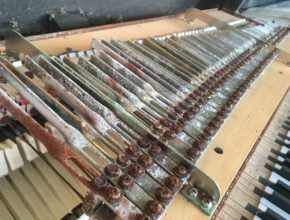6 Tips for Buying a Fender Rhodes Pianos
We can restore almost any Rhodes piano to its showroom condition as long as it doesn’t have extensive water or humidity damage. If you smell mold or mildew from the piano, restoring it may not be cost-effective.
1. Estimate the condition of the piano
Lift the plastic cover and look for signs of mold, or mildew. Mold and mildew have a distinct smell. Look for excessive rust, corrosion, and oxidation on the harp, tone bars, pickups, and tines. Check for cosmetic and structural issues, such as dents, damaged keys, and broken wood. Test all the keys to ensure they produce a consistent sound and have a smooth action. Inspect the keys and hammers to ensure minimal side-to-side movement. Check for wear of the hammertips, tines, grommets, damper felts, and damper arms. Make sure the sustain pedal is functional.
2. Verify the model and year
Familiarize yourself with different Rhodes models, such as Mark I, Mark II, or Mark V, and their respective features. Confirm the manufacturing year using the serial number, this can impact the instrument’s tone and value.
3. Evaluate the electronics
Test the electronics for proper functionality. If the piano is a Suitcase model, ensure the power supply, preamp, and speakers are in good working order. Be prepared to invest in repairs or upgrades if necessary.
4. Check the serial numbers
Make sure the original serial numbers exist. The piano serial number is located on the harp. Suitcase models have separate serial numbers for the piano and the amp. The amp’s serial number is located on the side of the amp.
5. Consider your budget and needs
Determine your budget and prioritize features that are most important to you, such as portability, sound quality, reliability, and ongoing maintenance.
6. Consult with a Rhodes technician
Schedule a free inspection in our workshop before you commit to buying the piano. Honest sellers will let you examine the instrument before the deal is finalized.
